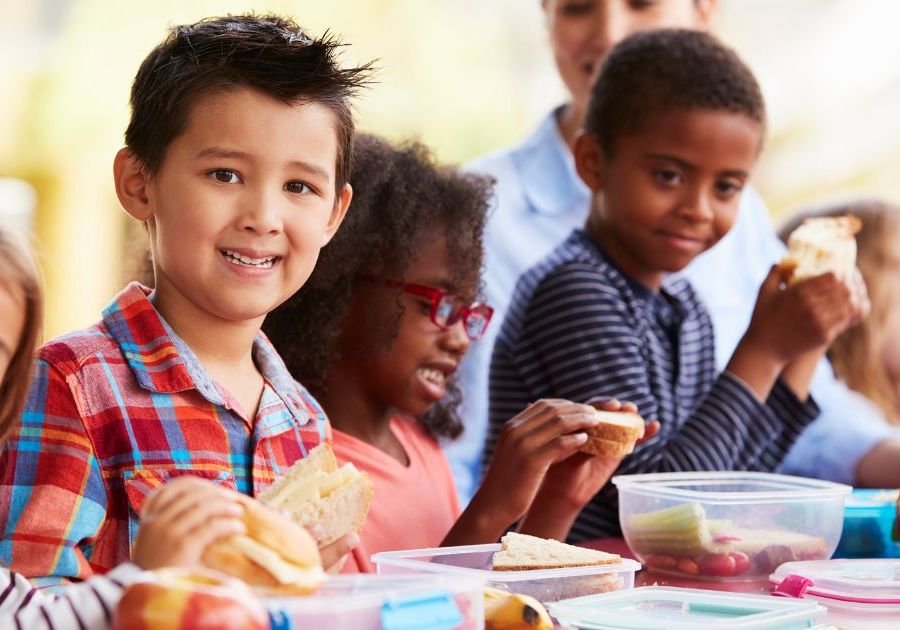Bags are packed, shoes are on the right feet, and kids are assembling with giddy anticipation at the bus stop with plenty of time to spare. But what else is missing to ensure a successful first day of school and a wonderful year of learning?
A solid lunch loaded with nutrition that is prepared at home!
I know moms and dads everywhere are groaning at that announcement, as packing school lunches can feel like a laborious and dreaded chore at the end of a long day, or during the early morning hours when everything feels so rushed and chaotic. I’ve been there! Many tired and over-extended parents are more than willing to let schools provide their children with at least one, if not two or more meals and snacks, most days of the week. It’s one less thing for parents to manage; although I would argue it’s actually one of the parental responsibilities we should desire to manage ourselves. Here’s why!
The truth is, as we have outsourced the nourishment of our kids to other entities and institutions, our children’s physical, emotional, and mental health has been declining rapidly, along with their appreciation for genuine whole foods. Our kids are becoming overly fond of highly processed meals, sugary beverages, industrialized desserts with a laundry list of fake ingredients, and low-quality proteins and fats. Some might even say they are addicted to these products. As a result, children and young adults are subject to more illnesses (acute and chronic), more weight-related conditions, and more cognitive and behavioral issues that impact their quality of life both at home and at school.
Nutrition impacts every facet of health because we are literally made of what we eat. Every single cell is built from the raw materials of the food we choose to consume. Proper nutrition is even more critical for our children, who are growing so rapidly, have such high energy demands, and are bombarded daily by an ever-growing list of environmental toxins and complex social issues. Our children are confronted with so many stressors these days…food need not be one of them.
As you read along, perhaps you’ll begin to understand that providing good food for your own child is an amazing privilege and not just a duty. Here are 5 tips to make this effort a sustainable endeavor that has the potential to benefit everyone in your family.
Tip #1 – Invest in a stainless steel bento box.
Not only do they minimize waste, their clever design and individual compartments provide consistent structure for building nutritious lunches. Some fresh fruit here, colorful veggies and dip there, a tiny nook there for something small and sweet, and a generous compartment in the middle for a satisfying protein. Two brands you might want to consider are PlanetBox and LunchBots. If you can avoid the plastic varieties, that is the preferable option – not just from a sustainability perspective, but toxic exposure as well. None of us need more plastic in our lives!
Tip #2 – Invest in a stainless steel thermos.
This simple and inexpensive addition will take your school lunch preparation to the next level! With something like a Thermos brand container (lots of cute and colorful options easily found at stores like Target or online), you are no longer confined to cold peanut butter and jelly sandwiches, bruised bananas, and snack packs of Goldfish and fruit gummies. When you can offer your kiddo warm homemade meals, a whole new world of possibility opens up! Cheesy scrambled eggs with bacon or sausage, comforting soups and stews, leftover rotisserie chicken, taco meat, meatballs and pasta, and even a plain burger or organic all beef hotdogs will easily serve as a warm and delicious ready-to-eat meal. Pro Tip: be sure to “prime” your thermos with hot water for a few minutes before adding heated food. Otherwise the entrée will be cold and uninviting by the time the lunch hour rolls around. I’ve found that food will stay warm in a Thermos for about 4 hours, and possibly longer.
Tip #3 – JERF = Just Eat Real Food!
As much as possible, and as quickly as you are able to make the full transition, begin to eliminate packaged snacks and junky treats from your children’s lunches. Sure, kids love them, and might gladly make an entire meal out of granola bars, potato chips, Cheez-its, Oreos, and Little Debbie cakes, but these foods are not providing the nutrients a growing child needs. Even worse, the poor quality ingredients are disrupting the gut, which then impacts immunity, cognitive function and mental health. It might take some time, and maybe a few tears (mainly from mom and dad…sometimes we are the most stubborn of all), but children can and will adapt to nutritious whole foods if adults will be patient, firm, consistent, and persistent.
Tip #4 – Focus on quality proteins and healthy fat when building meals.
Proteins not only provide the building blocks for the formation and maintenance of muscle, but also aid in proper immune function, wound healing, and antibody production. Proteins signal chemical reactions within the body and support cellular transport. In addition to all of that, proteins are satiating – which means they keep us fuller for longer and support better brain function and focus. In a similar way, healthy fats slow down our digestion and provide lasting energy, unlike processed carbohydrates, which burn like dry kindling. Fats also help protect vital organs and cushion joints, as well as provide the raw materials for all of our hormones. Not to mention that fat makes food taste good! The top food recommendations that include both fat and protein would be animal products - specifically meat, cheese, and eggs. There are plant sources of these nutrients as well, and these can be substituted as desired, but they are not as bioavailable (readily available to the body) as animal sources.
Tip #5 – Keep it simple!
So many moms and dads stress unnecessarily about making school lunches picture-perfect and Pinterest-worthy. It can be fun to make lunches colorful and creative, but it doesn’t have to be a tedious or painstaking process. I’ve found my kids are perfectly happy to rotate through about 4-5 different meals, and these meals always contain the same basic components: protein, fat, and some whole food carbohydrates like vegetables and fruit. You can vary the produce from one season to the next to keep things interesting, but there is no requirement (and no bonus points) for heart-shaped sandwiches or cute animals carefully chiseled out of fruit and decorated with assorted nuts and raisins. The nutrients are important; the “wow factor” is not. Get your kids involved in the daily prep, and let them choose a few items to include in their lunches. Hopefully, in time, you can pass off the entire process to them!
If you are a visual learner, be sure to check out all of the amazing lunch options pictured here. You can even search according to dietary needs (nut-free, gluten-free, egg-free, and so on). Lots of ideas and resources to get you started! This is an investment of your time and energy, and it will pay back long-term dividends in our children’s healthy bodies and strong minds. Here’s to an amazing school year and delicious lunches packed with love!
Amy is a mom and nutritionist with the following distinctions: Primal Health Coach (PHC), Functional Nutritional Therapy Practitioner (FNTP), Functional Blood Chemistry Specialist (FBCS), and Functional Hormone Specialist (FHS)



